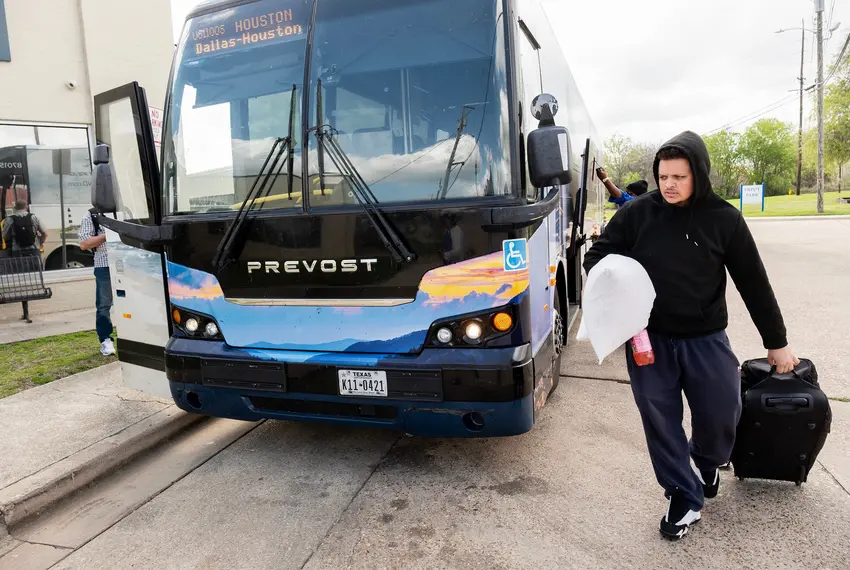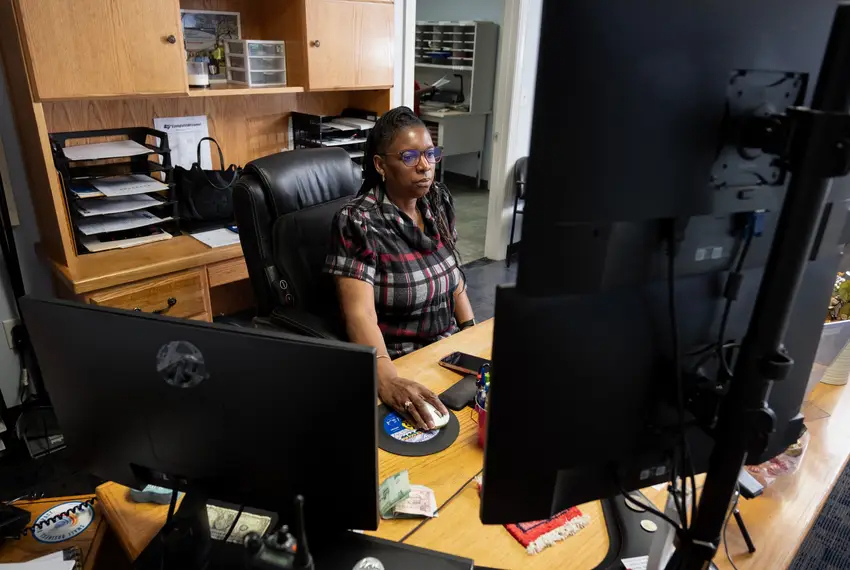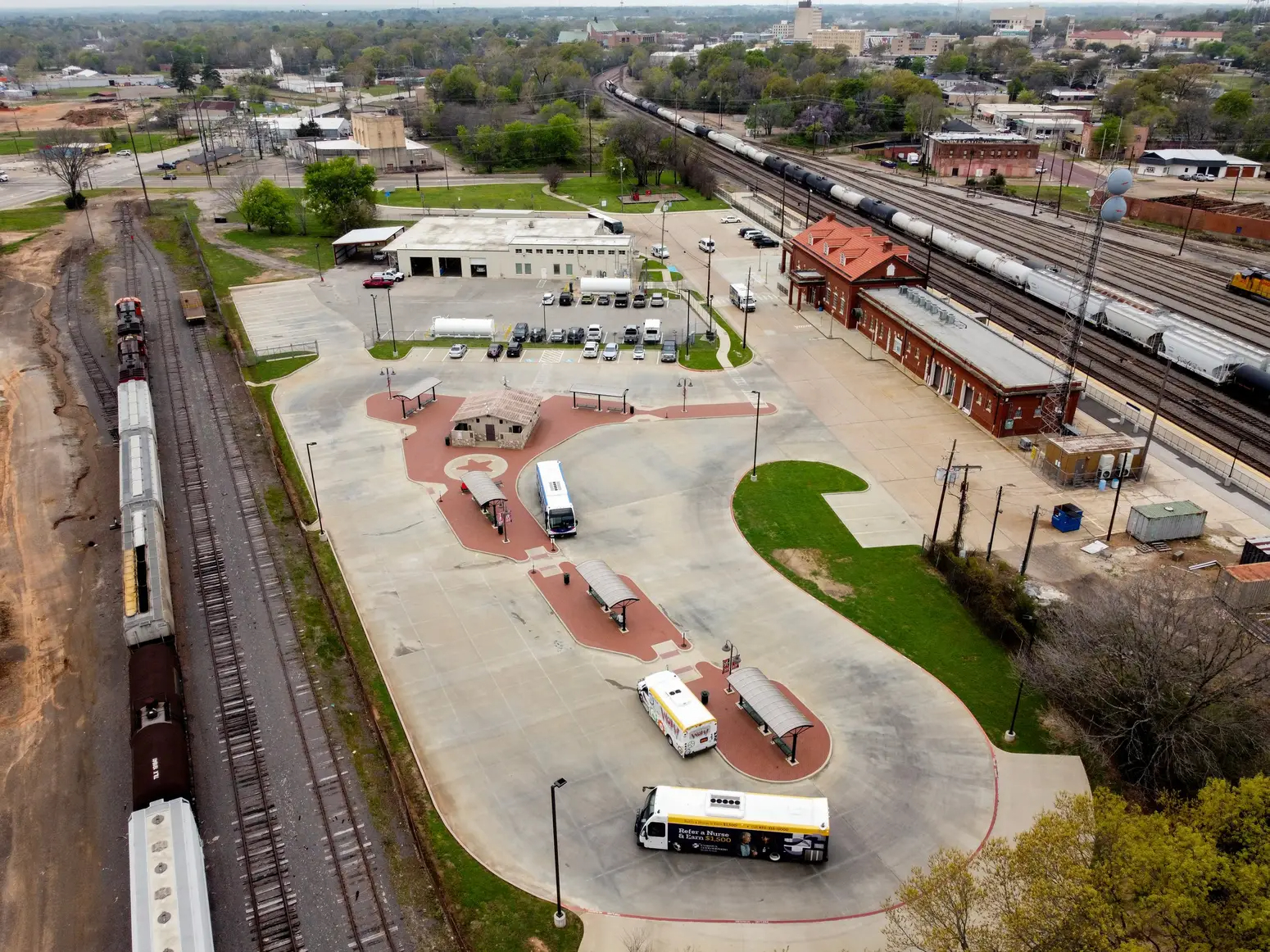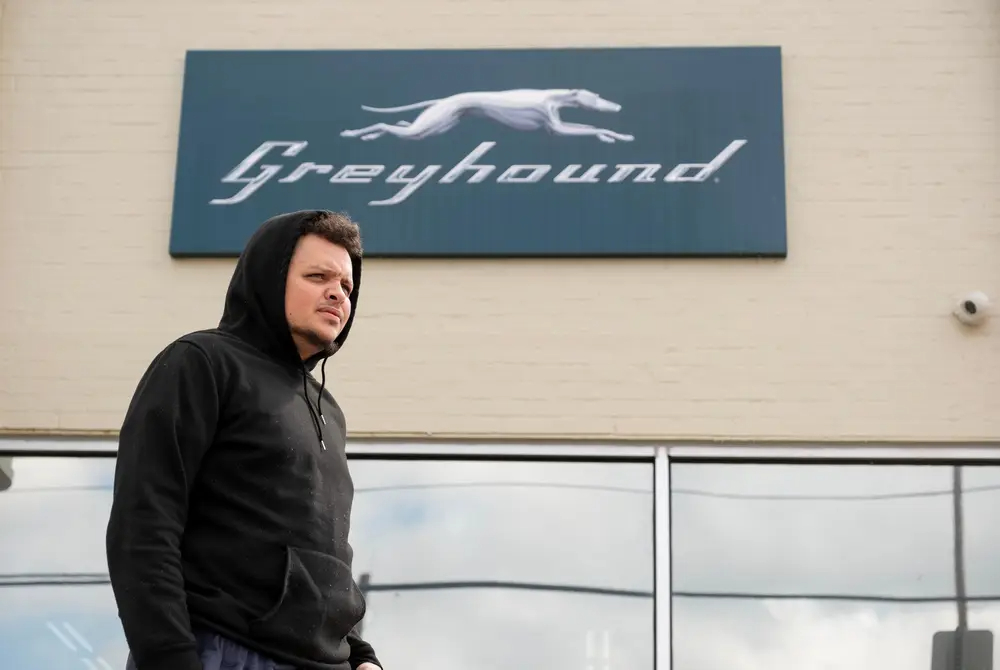
By Jess Huff, The Texas Tribune
LONGVIEW Michelle Smith never learned to drive.
The 54-year-old East Texas woman has relied upon public transportation for most of her life. She fondly remembers long trips across the state with her grandmother on Greyhound buses. After she married, her husband drove her until he died six years ago. That’s when she returned to the bus station.
Which is why, on a recent Wednesday afternoon, she was sitting in the Longview bus station, a trash bag of clothes in the seat beside her, a purse and a water bottle from the hospital in her lap.
Smith, who was recovering from surgery, was debating whether to use the local bus system to take care of errands or jump on a Greyhound to Tyler. Either way, she could go anywhere she wanted from Longview’s renovated bus depot — a central hub for the town’s carless population and other travelers.
Scenes like this are becoming rare in the U.S. Nationwide bus station are closing in cities like Richmond, Philadelphia, and Dallas. A major shakeup in the mass transit industry, coupled with a shift in ridership following the COVID-19 pandemic, is driving the closures, experts say.
FlixBus, a Germany-based company, bought Greyhound’s massive fleet of buses in 2021. At the same time, Twenty Lake Holdings, a subsidiary of Alden Global Capital, bought Greyhound’s property and other assets. All the while, bus companies are shifting to pick up and drop off passengers at hotels, shopping centers and on roadsides instead.
Longview transportation officials were surprised to learn Greyhound planned to close its station in June 2022. Scott Lewis, the Longview Transit general manager, said he saw Greyhound as a piece of a much larger transit system.
“To suddenly just lose that part of it, it just didn’t make sense,” he said.
Longview went to work and reached a deal with Greyhound months later to reboot services. The deal included a small amount of new revenue for the city. The city also opted to renovate the bus station, which concluded with a ceremonial ribbon cutting in May 2023.
Nearly a year into its investment, Longview officials are pleased with their decision. As is Flixbus, Courtney Castaneda, a spokesperson for the company, said this is an ideal solution for communities as Greyhound loses access to its bus stations.
“Given that intercity bus travel frequently involves transfers to reach destinations, these connections, whether within a single carrier or between interlined carriers, underscore the necessity for robust public-private partnerships,” she said.

Earlier this month, passengers reclined on benches just outside the terminal doors, enjoying the breeze even as clouds brought intermittent sprinkles of rain. The flow of people inside the terminal, a few blocks outside of downtown Longview, ebbed as buses pulled in and out.
Among the mass transit companies that operate at the depot: Amtrak, Longview Transit, the local bus service, and Go Bus, a regional line. Greyhound also picks up and drops off passengers at this location as part of the deal the city struck with the company two years ago.
Tequita Dudley, the Longview Transit director of operations, said the bus station is busy for a city of Longview’s size. In a community of 82,531 people, Longview’s transit system provided more than 135,000 trips in 2022, the latest agency profile shows.
“Our depot is very well alive and used in the city,” she said. “We get hundreds of people every day. People come through and they see it’s empty and think nothing is happening here, but when the train comes in and the buses come in, this depot is busy.”
As part of the deal the city struck with Greyhound, Longview transportation employees on Dudley’s team manage a ticket counter. This was important to city officials who saw mass confusion among bus riders after Greyhound closed its terminal at the bus depot.
Longview also won a $96,000 grant from the Federal Transit Administration to expand the dispatch and customer service desk, install new lighting and flooring, and to paint the facility.
Because the Federal Transit Authority requires matching grant funds, the Texas Department of Transportation stepped in for the initial grant. And as part of the contract with Greyhound, Longview receives a small commission for selling tickets which the city is using to bolster the grant funds account for future projects.
The facelift was noticeable to Curtavion Saunders.
The 24-year-old, stepped off the Greyhound from Shreveport in a hoodie and sweatpants, a pillow thrown over his shoulder, and immediately began looking for his baggage in the bus’ undercarriage.
The trip from Shreveport was the last leg of his 19-hour journey from Iowa where he attended his grandmother’s funeral. He took four different buses with layovers in four different cities, the first two of which he couldn’t remember the names of, to get back to Longview and was ready for a friend to drive him home.
“I’ll never travel like that again,” he said. “The midwest bus stops were garbage.”
Saunders was grateful to be back in the south, where the Longview and Shreveport stations were easily the best ones he stopped in. Where the midwest bus stations were “run down,” the Longview and Shreveport stations were cleaner and well maintained, he said.

Crime and blight are also central to the debate over what to do with bus stations.
In Houston, Greyhound relocated its main terminal from downtown as it lost access to the land. Residents in Magnolia Park, where the new pick-up point is, told the Houston Landing they worried the crime in the city’s old Greyhound bus station would take root in the new station now located closer to their homes.
Likewise, city leaders in Dallas are searching for solutions to the pending closure of the downtown Greyhound station. One of which is the establishment of a hub where a proposed high-speed rail line would stop in the city. This proposal was met with both celebration and criticism. Community developers worry about how it would impact real-estate development while city leaders see this as a way to support people who wouldn’t be mobile otherwise.
Michael Walk, a research scientist at the Texas A&M Transportation Institute, said he saw value in cities taking over bus depots like Longview. Transportation, he said, is a fundamental need for every person, and it’s an economic engine for communities.
“Even if I don’t use those services, they still have value,” he said. “Other people that I rely on, other people I know, need those services. They need those bus stations and need to be able to do inter regional trips. And it supports the local economy and the Texas economy. It supports the things that I rely on, day in and day out.”
Travel within and between cities on buses dropped significantly during the COVID-19 pandemic.
Both long bus rides between states and shorter stints between cities, such as Dallas to Houston, have regained popularity following the steep decline in 2020. Researchers at The Chaddick Institute for Metropolitan Development at DePaul University in Chicago found travel will return to pre-pandemic levels by 2026, according to the annual Intercity Bus Review.
Luxury bus services in Texas have expanded operations in recent years, but their more economical counterparts are cutting back. Greyhound stations have closed in Texas and other U.S. regions, leaving travelers to instead rely upon roadside bus stops, the report states.
Meanwhile, intracity transit has been slow to return in cities like Houston or Austin. But it has returned in full force in smaller metropolitan areas, Walk said in a podcast interview for the transportation institute.
This results from the type of riders who rely upon these services in smaller urban areas compared to their counterparts.
In big cities, there is a mixture of riders who need the bus and those who take transit by choice; the working professionals who could drive if they wish or college students. In places like Longview, bus riders often have no other option. Having a station is a necessity, not a luxury, for those who use these services, Walk said.
“We don’t have those ‘choice riders’ we have more of the [riders] that have to have it,” Lewis said. “That’s the only way they’re gonna get to the grocery store, to the Social Security office, to get to their – many times – minimum wage to low end jobs.”

People need the opportunity to move around, whether it’s between cities, or within them, Walk said.
As much of East Texas still goes without broadband, many of the riders don’t have access to the internet to purchase tickets online, or they need help navigating the system anyway. And they can be stuck waiting hours between rides, depending on which services they need to use.
This type of setup is ideal for Flixbus, Castaneda said. When a station is set to close, the company said it prefers to work with cities to find an alternative option to continue providing those services.
“Given that intercity bus travel frequently involves transfers to reach destinations, these connections, whether within a single carrier or between interlined carriers, underscore the necessity for robust public-private partnerships, necessitating cooperation from municipalities and the public sector to facilitate access to transit infrastructure supporting the national intercity bus network,” she said.
Shannon Jackson, a 62-year-old certified medical assistant, was waiting at the outside terminal for an intra city bus to take her to her doctor’s appointment. She moved to Longview about a year and a half ago from Tyler and said she appreciates the small town feel, especially how peaceful and quiet the community is.
“I feel safe here,” she said. “Rather than in Chicago or New York where the bullets are flying or there’s carjacking. I want to be safe in my old age, to live somewhere peaceful and quiet.”
She uses the bus for everything, from shopping, to the pharmacy, the doctor, the library and the post office. At this point, the drivers know her and she knows them. She knows who will be grumpy and who will be more lenient if she’s running a few minutes late.
And she appreciates the changes made to Longview’s terminal.
Disclosure: Texas A&M Transportation Institute has been a financial supporter of The Texas Tribune, a nonprofit, nonpartisan news organization that is funded in part by donations from members, foundations and corporate sponsors. Financial supporters play no role in the Tribune’s journalism. Find a complete list of them here.
This article originally appeared in The Texas Tribune at https://www.texastribune.org/2024/03/21/east-texas-longview-bus-station/.
The Texas Tribune is a member-supported, nonpartisan newsroom informing and engaging Texans on state politics and policy. Learn more at texastribune.org.



